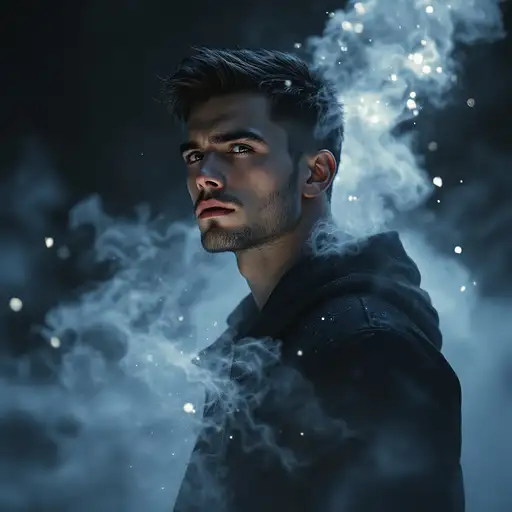


7 months ago
Abstract Full-Body Portrait of a Prostitute – Salvador Dalí (Late-Life Style, Singular Focus & Pure Surrealism) (Surrealism:1.7, Salvador Dalí late-life style:2.0, Dreamlike distortion:1.6, Hyperreal textures:1.5, Chiaroscuro contrast:1.4, Oil-painting brushstrokes:1.5, Organic fluidity:1.6, Metaphysical realism:1.4) A full-body surrealist portrait of a prostitute, painted in the unmistakable late-life style of Salvador Dalí, where dream logic dictates form and reality bends into its own subconscious reflection. She stands alone in the void, a lone figure frozen in motion yet melting into time itself. Her body is elongated but coherent, her limbs refined into one singular, fluid, organic motion, as if she is a sculpture made of half-formed candle wax, melting at the edges but never fully dissolving. Her face remains untouched by distortion, hyperreal and melancholic, eyes darkened with kohl, staring directly outward, unblinking, as if confronting time, fate, and the fabric of reality itself. A single strand of jet-black hair escapes from her carefully pinned curls, swaying in an invisible breeze. Her lips—painted a deep, blood-red—drip slightly at the edges, as if smeared by unseen hands, caught between seduction and sorrow. Her dress, a relic of the past, is a contradiction of luxury and decay, the hem transforming into thin wisps of smoke, curling and dispersing into the canvas. The fabric is stretched unnaturally, its folds elongating like the melted forms of Dalí’s classic clocks, one shoulder slipping in an eternal descent, never quite falling. The setting is an infinite, surreal landscape—a lonely street with no visible end, where shadows stretch longer than their owners, and the cobblestones appear to melt into liquid mercury. In the background, a large, antique pocket watch, twisted and partially submerged in the air, hangs frozen at an uncertain hour, its hands warped into elongated spirals. A single red rose, impossibly large and impossibly alive, hovers just behind her, its petals peeling away like fragments of forgotten love letters. The air feels thick, painted with visible brushstrokes, where light and shadow do not obey the laws of physics—instead, they bleed into one another, wrapping around her body in soft, liquid chiaroscuro, mimicking the curvature of a dream. She is not merely a woman but a symbol—of desire, of loss, of something slipping through time like sand through Dalí’s own fingers.

7 months ago
Create a double-exposure image capturing the terrifying transformation of a werewolf mid-change, blending two intense layers: Foreground: A human figure—eyes wide with pain and primal rage—as their body twists and contorts in unnatural ways. Their skin is ripping, stretching, and growing fur, their hands elongating into clawed paws, and their mouth opening in a scream that shifts into a feral snarl. Their expression is a mix of terror, agony, and the inevitable pull of the beast within. Background: The fully transformed werewolf—a towering, monstrous creature with glowing eyes, powerful limbs, and fur bristling in the moonlight. Its snout is curled in a savage growl, and its claws glisten, ready to strike. The backdrop features a dark, misty forest under a full moon, its eerie light cutting through the swirling fog. The double exposure effect should blend the two figures together—the human dissolving into the beast, as if caught in the nightmarish in-between state of transformation. The moonlight casts an eerie glow, highlighting the tension between man and monster. The colors should be a mix of cool blues, grays, and silvers, contrasted with the deep shadows of the forest. This image should capture the horror, power, and inevitability of the werewolf’s curse, evoking both fear and fascination.
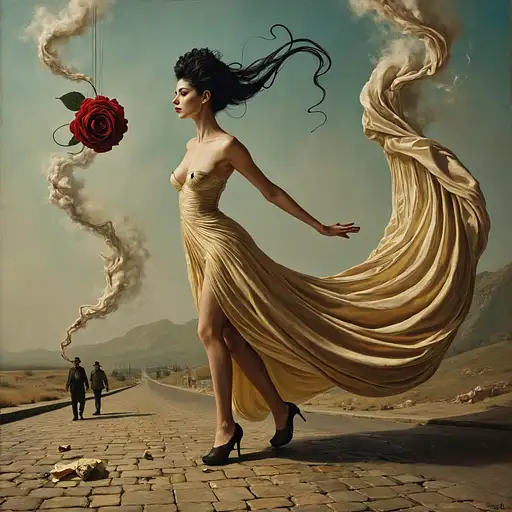
7 months ago
(Surrealism:1.7, Salvador Dalí late-life style:2.0, Dreamlike distortion:1.6, Hyperreal textures:1.5, Chiaroscuro contrast:1.4, Oil-painting brushstrokes:1.5, Organic fluidity:1.6, Metaphysical realism:1.4) A full-body surrealist portrait of a prostitute, painted in the unmistakable late-life style of Salvador Dalí, where dream logic dictates form and reality bends into its own subconscious reflection. She stands alone in the void, a lone figure frozen in motion yet melting into time itself. Her body is elongated but coherent, her limbs refined into one singular, fluid, organic motion, as if she is a sculpture made of half-formed candle wax, melting at the edges but never fully dissolving. Her face remains untouched by distortion, hyperreal and melancholic, eyes darkened with kohl, staring directly outward, unblinking, as if confronting time, fate, and the fabric of reality itself. A single strand of jet-black hair escapes from her carefully pinned curls, swaying in an invisible breeze. Her lips—painted a deep, blood-red—drip slightly at the edges, as if smeared by unseen hands, caught between seduction and sorrow. Her dress, a relic of the past, is a contradiction of luxury and decay, the hem transforming into thin wisps of smoke, curling and dispersing into the canvas. The fabric is stretched unnaturally, its folds elongating like the melted forms of Dalí’s classic clocks, one shoulder slipping in an eternal descent, never quite falling. The setting is an infinite, surreal landscape—a lonely street with no visible end, where shadows stretch longer than their owners, and the cobblestones appear to melt into liquid mercury. In the background, a large, antique pocket watch, twisted and partially submerged in the air, hangs frozen at an uncertain hour, its hands warped into elongated spirals. A single red rose, impossibly large and impossibly alive, hovers just behind her, its petals peeling away like fragments of forgotten love letters. The air feels thick, painted with visible brushstrokes, where light and shadow do not obey the laws of physics—instead, they bleed into one another, wrapping around her body in soft, liquid chiaroscuro, mimicking the curvature of a dream. She is not merely a woman but a symbol—of desire, of loss, of something slipping through time like sand through Dalí’s own fingers.

7 months ago
A spectral figure, half-formed from wisps of silver and shadow, rises from the still body below. The soul, luminous and fragile, drifts upward, dissolving into the vast, obsidian void speckled with fading embers of existence. Ethereal ribbons of light stretch and coil around the departing essence, whispering the echoes of forgotten dreams. The air shimmers with an eerie, unearthly glow—both mournful and divine. A silent wind carries the final breath into the infinite unknown, where the veil between life and eternity shivers and parts. Beauty and sorrow intertwine in a delicate ballet of departure, as the universe inhales the lost soul into its boundless embrace.
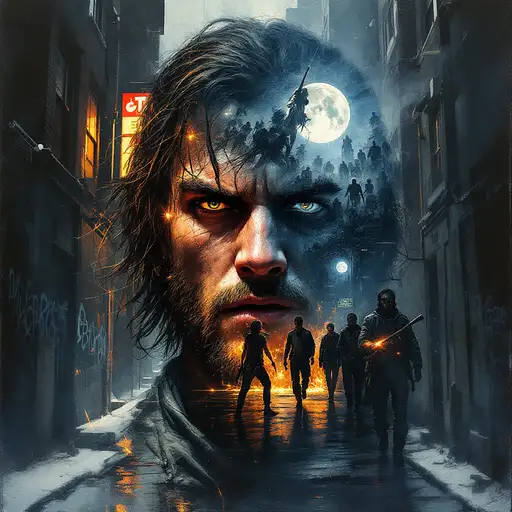
7 months ago
Craft a dynamic and emotionally charged oil painting that uses the double exposure technique to capture the raw energy, unity, and struggles of The Warriors. The central figure should be one of the Warriors, such as Swan, his face half-translucent and fierce, embodying both the individual and collective spirit of the gang. His expression should be filled with determination and defiance, while his figure dissolves into the gritty, chaotic streets of 1970s New York City—dark alleys, graffiti-tagged walls, and the stark silhouettes of neon lights. His features should bleed into the urban landscape, as though he is both a part of the city and a symbol of rebellion against it. Inside his form, a web of interconnected images from the Warriors' journey should emerge: the haunting image of the baseball bat-wielding Rogues, the fire-lit glow of the moonlit escape across subway tunnels, and the strong camaraderie of the Warriors themselves, seen through their shared struggles and brotherhood. The double exposure should seamlessly integrate these elements into his figure, illustrating the tension between individual survival and the unbreakable bond of the gang as they face overwhelming odds together. The color palette should reflect the gritty urban feel of the film, with cool blues, grays, and blacks contrasted with the neon oranges, reds, and greens of the streetlights and graffiti. The atmosphere should feel electric, filled with an undercurrent of danger, defiance, and unspoken loyalty. The oil painting should evoke a sense of movement—like a snapshot of the Warriors running through the night, the harsh cityscape blurring into their form, and the struggle against the forces that threaten to tear them apart. This double exposure composition should not only explore the Warriors' journey through the hostile streets but also the emotional and psychological depth of their fight for survival and unity. The contrast between the rawness of their environment and the bond they share should be at the heart of this painting, encapsulating the spirit of The Warriors as a timeless symbol of resilience and brotherhood.
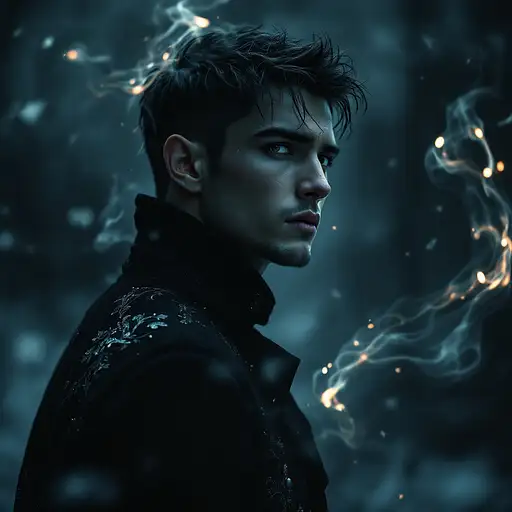
7 months ago
A young man with sharp facial features, short dark hair,muscular body wearing meadival inspired silver embroided black coat and deep, expressive eyes stands alone in dark His chiseled jawline and subtle stubble add to his striking, melancholic expression. , volet eyes His gaze is lost in the distance, haunted by memories of a lost love. Wisps of ethereal mist swirl around him, forming ghostly hands reaching out before dissolving into the cold night air.glow on his face, emphasizing his loneliness and regret. , enhancing the cinematic, dreamlike atmosphere. The background dark blurred as if seen through teary eyes. The image is highly photorealistic, with intricate details in skin texture, lighting, and atmospheric depth, evoking deep emotion
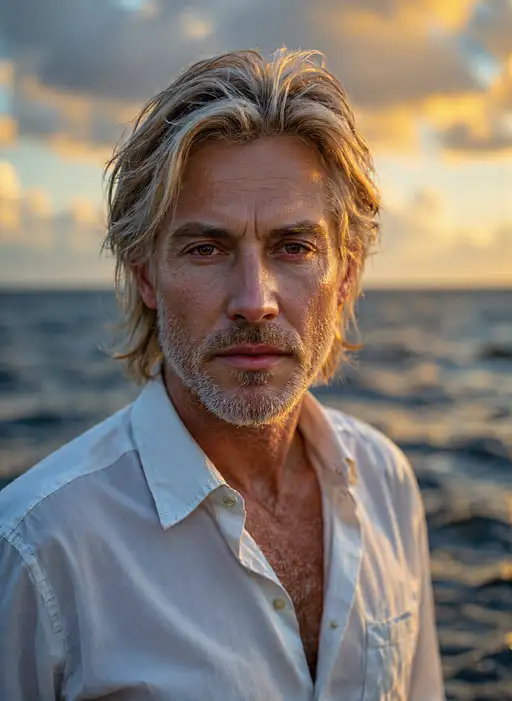
8 months ago
Transport yourself into an exquisite portrait that encapsulates the essence of a distinguished middle-aged gentleman standing resolutely on the majestic deck of a luxurious yacht, bathed in the enchanting hues of a captivating sunset. Employing the remarkable capabilities of the revered Canon EOS R5 camera, coupled with a premium 100mm lens opened wide to an alluring F 1.2 aperture, the background seamlessly dissolves into a mesmerizing tapestry of bokeh, allowing the subject to command undivided attention. The boundless expanse of the ocean stretches into the horizon, harmonizing with the vibrant sunset, its painterly strokes adorning the sky with a kaleidoscope of colors. Soft, golden light gracefully cascades upon the man’s countenance, caressing his features with a tender glow that accentuates his rugged yet refined allure. A dreamlike lighting arrangement imbues the scene with an aura of serenity and tranquility, embracing the observer in a moment of sublime harmony. The cutting-edge Midjourney v5, meticulously calibrated in photorealism mode, employs advanced algorithms to authentically capture every facet of the man’s captivating personality, rendering the image with unparalleled realism and evoking a profound connection with the viewer. With each contemplative gaze, this extraordinary portrait invites you to unravel the captivating story etched upon the visage of this remarkable gentleman.

6 months ago
Create a hyper-realistic surreal portrait where reality fractures into beautiful impossibility: a modern japanese femme fatale whose amber eyes emit an otherworldly luminescence , her liquid-obsidian hair defying gravity in a high ponytail where strands transform into ethereal smoke, intertwining with floating black pearls particles that orbit her form like microscopic galaxies, while her hair accessory morphs between solid and liquid states, defying physics by dripping upward into the void, her choker manifesting impossible geometries that pulse with mechanical life as the designer pendant seems to sink into a dimension beneath her skin creating reality ripples, her sleek latex corset-style top with a plunging sweetheart neckline reflecting light in physically impossible ways - simultaneously absorbing all light while emitting otherworldly bioluminescence, its material state fluctuating between liquid, solid, and vapor in mesmerizing paradox, each seam and curve of the fitted bodice creating ripples in the fabric of reality itself, skin transitioning between porcelain smoothness and crystalline fragments where golden circuit-like veins peek through the epidermis that fractals into infinite patterns, iridescent lips shifting colors with every angle despite the static nature of the image, all while the background warps into a vortex of inverse watercolor physics where paint flows against gravity and abstract forms suggest familiar shapes that dissolve upon focused attention, multiple impossible light sources creating contradictory shadows and highlights that challenge spatial perception, with microscopic details revealing infinite recursions hidden within textures that become increasingly surreal upon closer inspection, the entire composition dancing on the knife-edge between photorealistic precision and impossible surrealism, manifesting as a beautiful hallucination captured in perfect clarity where every element seems to breathe and move in peripheral vision yet remains hauntingly still when directly observed, creating an image that feels like a dream made tangible through digital artistry.

5 months ago
"Abstract surrealist album cover in painterly style, a human head dissolving into vibrant clouds of color and light, symbolizing emotion and thought explosion. Soft brush strokes, neon accents, flowing textures in pastel pinks, purples, and electric blue. Dreamlike composition with an artistic, expressive atmosphere. High contrast, modern gallery feel, no text."

9 months ago
A chaotic and vivid depiction of an archangel’s desperate escape from hell (1.5), bursting through an endless sea of demons (1.4). The screen is filled with the writhing forms of countless grotesque creatures (1.6)—clawed hands (1.3) and twisted faces (1.3), their bodies an ocean of chaos and darkness (1.4) that stretches infinitely downward (1.3). Their fiery eyes glint with rage and desperation (1.5) as they claw upward, their blackened, smoky forms illuminated by the burning rivers of molten lava (1.4) coursing through the underworld. At the center of this chaos (1.4), the archangel appears small but unyielding (1.5)—a beacon of divine light (1.6) in a world consumed by fire and shadow. His radiant golden wings (1.5), tinged with hues of celestial blue (1.4) and fiery orange (1.4), struggle to break free of the mass of demons dragging him down (1.5). The light from his wings cuts through the smoky darkness (1.6) like shards of sunlight piercing a storm (1.3), creating a stark contrast to the hellish environment (1.4) around him. The angel’s form is dynamic (1.5), twisting mid-flight (1.4) as his powerful wings beat against the swarm (1.5). His robes, glowing faintly from within (1.4), are torn and tattered (1.3) from the ferocity of the battle. His hands grip a radiant celestial sword (1.5), its edge shimmering with divine fire (1.6), as he swings it downward (1.4), cutting through the demons clinging to his legs and arms (1.6). Streams of golden light trail behind the sword (1.5), slicing through the oppressive darkness (1.4). The demonic horde dominates the frame (1.6), their grotesque forms swirling and climbing over one another (1.4) in a desperate attempt to pull him back into the abyss (1.5). Clawed hands (1.4) reach upward, grasping at the angel’s robes, wings, and even his sword (1.5), while others are thrown back by the sheer force of his divine light (1.6). The demons’ smoky, ethereal bodies (1.5) dissolve and re-form (1.4), creating a sense of endless motion and chaos (1.6). The background is a hellish landscape (1.4), filled with erupting volcanoes (1.3), glowing rivers of lava (1.5), and jagged blackened rocks (1.3). The air is thick with smoke, ash, and embers (1.4), swirling in a fiery haze (1.5) that fills the scene with energy and tension. High above, faint traces of the heavens (1.4) are visible through the swirling chaos (1.3)—a glimmer of hope in the distance (1.5), beckoning the angel forward. The artistic style is inspired by Makoto Shinkai (1.6), with his signature ethereal lighting and emotional depth. Vibrant, dynamic lighting (1.5) contrasts the angel’s holy glow (1.6) with the fiery reds and blacks of the underworld (1.4). Rays of divine light pierce the chaos (1.5), creating an otherworldly palette of warm and cool tones (1.4) that evoke both awe and despair (1.5). The intricate details of the demons (1.4), the angel’s wings (1.5), and the molten landscape (1.3) add a sense of depth and movement, immersing the viewer in this epic struggle between good and evil (1.6).
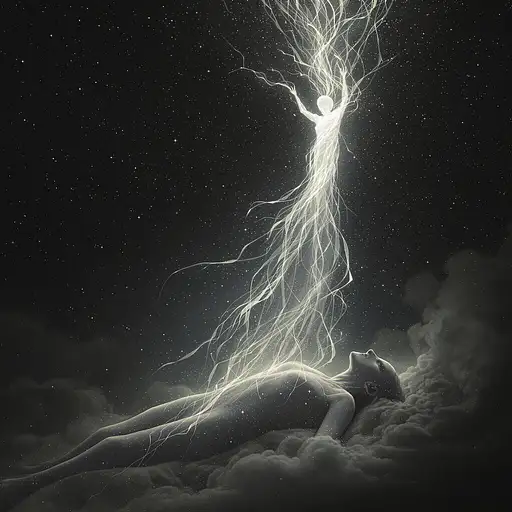
8 months ago
A spectral figure, half-formed from wisps of silver and shadow, rises from the still body below. The soul, luminous and fragile, drifts upward, dissolving into the vast, obsidian void speckled with fading embers of existence. Ethereal ribbons of light stretch and coil around the departing essence, whispering the echoes of forgotten dreams. The air shimmers with an eerie, unearthly glow—both mournful and divine. A silent wind carries the final breath into the infinite unknown, where the veil between life and eternity shivers and parts. Beauty and sorrow intertwine in a delicate ballet of departure, as the universe inhales the lost soul into its boundless embrace.

8 months ago
Moon Knight dissolving into swirling sand, ultra-realistic, in the style of Marvel Comics, volumetric dust, cinematic lighting, close-up portrait --ar 1:2 --personalize 2gwf1qc --stylize 750 --v 6.1

8 months ago
A disoriented young man in quantum fluctuation state, fractured mirrors reflecting multiple selves, swirling Klein Blue liquid metal forming question marks, translucent skin revealing holographic neural networks, hands emitting Schrӧdinger's cat particle effects, floating Sanskrit glyphs dissolving into binary codes, cybernetic monastery architecture collapsing into Penrose stairs, dramatic gamma-ray burst lighting with bioluminescent veins, hyper-detailed surrealism trending on ArtStation, intricate sci-fi textures by Beeple and Moebius, 8k cinematic rendering --ar 16:9 --v 5.2

6 months ago
An award-winning oil painting masterpiece using the double exposure technique to capture the haunting beauty and emotional depth of Mull of Kintyre by Paul McCartney and Wings. The composition merges the face of a person, filled with longing and nostalgia, with the mist-covered, rugged cliffs of the Mull of Kintyre. The figure’s face gently dissolves into the dramatic landscape, where rolling hills meet the crashing waves of the Atlantic Ocean. The soft, ethereal light of the setting sun bathes the scene in golden hues, highlighting the wind-swept grasses and the distant lighthouse, standing as a symbol of hope and longing. In the background, the faint outline of a Scottish village rests on the shoreline, its buildings blending into the soft mist, reflecting the song’s themes of home, nature, and connection to the land. The brushstrokes are smooth yet textured, capturing the mist and the lush greenery of the Scottish Highlands, with a color palette of earthy greens, soft blues, and warm sunset oranges. The emotional atmosphere is one of bittersweet reflection, evoking the deep sense of connection to a place and the longing for return. This masterpiece visually interprets the spirit of Mull of Kintyre, embodying a love for a beloved landscape, a place forever etched in memory

5 months ago
A surreal romantic painting of two abstract figures dissolving into one another, painted with soft brushstrokes and flowing forms. Their bodies made of glowing memories — fragments of handwritten letters, golden light, and rose petals drifting in the air. The background is a dreamy void blending watercolor textures in faded mauve, vintage cream, and dusty rose. The atmosphere is emotional and timeless, echoing the feeling of doing it all again — with no regrets. Style: emotional surrealism, cinematic lighting, poetic composition, delicate details.

9 months ago
Create an ultra-detailed, photorealistic macro photograph of a stunning black tarantula in a lush, enchanted mossy forest. The tarantula’s glossy, jet-black exoskeleton glistens under soft, diffused light, highlighting intricate textures of its velvety hairs and the segmented patterns on its abdomen. Its large, reflective eyes glimmer with faint amber highlights, conveying a sense of quiet alertness. The spider rests gracefully on a vibrant bed of emerald-green moss, dotted with dewdrops that catch the light like tiny diamonds. Around it, the forest floor thrives with rich textures—fuzzy moss carpets, delicate fern fronds, and decaying bark covered in lichen. The background dissolves into a dreamy bokeh of misty greens and earthy browns, with faint sunlight filtering through towering trees. Shallow depth of field emphasizes the tarantula's striking form, while hyperrealistic details (4K resolution) showcase every spine on its legs, the subtle iridescence of its fangs, and the moisture clinging to its surroundings. The atmosphere feels mystical, serene, and alive with the quiet hum of nature."

6 months ago
A powerful, cinematic fantasy artwork depicting a mythic figure ascending in a blaze of divine fire. A muscular, androgynous humanoid angel with molten-black skin stands upright, eyes closed in serene defiance, as fire-laced wings unfurl from their back in sweeping arcs. The wings are made of trailing strands of ember and smoke, flickering with fiery golds, burnt oranges, and glowing reds, dissolving into radiant sparks. The angel’s body is statuesque, textured like obsidian, cracks glowing faintly with internal heat. Around them, a dramatic, smoldering environment burns and swirls—ash falling like snow, light rays piercing through a turbulent golden-orange sky. The ground is scorched but glowing. The atmosphere radiates with a sense of ascension, sacrifice, and transformation. Hyper-realistic detailing, flowing motion, embers and particles suspended midair, high contrast cinematic lighting, warm glowing ambiance. Mythological tone, reminiscent of Icarus or a fallen celestial rising once again. Ultra-detail, 8K resolution, painterly fire-sculpted elegance.

7 months ago
Two souls stand hand in hand beneath an endless sky, surrounded by a dreamy, surreal landscape bathed in celestial light. The couple glows faintly, their silhouettes gently illuminated by the starlight, gazing into each other with tenderness and quiet intensity. Their presence radiates intimacy, caught in a timeless moment where reality and fantasy dissolve.

6 months ago
A young man with sharp facial features, short dark hair,muscular body and deep, expressive eyes stands alone in dark His chiseled jawline and subtle stubble add to his striking, melancholic expression. ,His gaze is lost in the distance, haunted by memories of a lost love. Wisps of ethereal mist swirl around him, forming ghostly hands reaching out before dissolving into the cold night air.glow on his face, emphasizing his loneliness and regret. , enhancing the cinematic, dreamlike atmosphere. The background dark blurred as if seen through teary eyes. The image is highly photorealistic, with intricate details in skin texture, lighting, and atmospheric depth, evoking deep emotion

6 months ago
A young man with sharp facial features, short dark hair, and deep, expressive eyes stands alone in dark His chiseled jawline and subtle stubble add to his striking, melancholic expression. His gaze is lost in the distance, haunted by memories of a lost love. Wisps of ethereal mist swirl around him, forming ghostly hands reaching out before dissolving into the cold night air. glow on his face, emphasizing his loneliness and regret. , enhancing the cinematic, dreamlike atmosphere. The background dark blurred as if seen through teary eyes. The image is highly photorealistic, with intricate details in skin texture, lighting, and atmospheric depth, evoking deep emotion
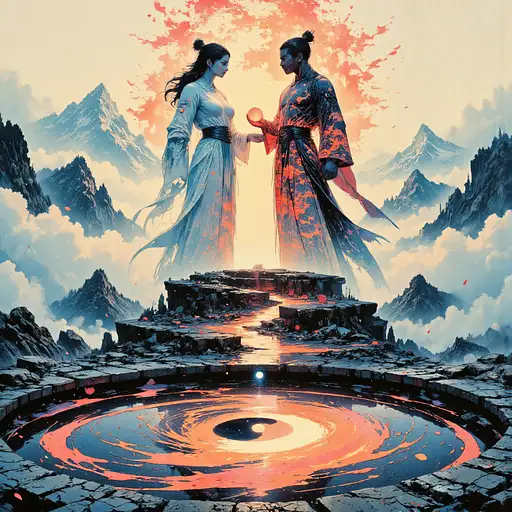
3 months ago
Epic ink-wash x anime-cel fusion, high-detail, sweeping cinematic scale, soft golden hour light — A vast circular stone dais floats above misty mountain peaks, wreathed in drifting clouds. At its centre rises a **towering Yin–Yang monolith** (two interlocking half-figures)::1.5 ◉ **Yin side – moonlit tranquility**::1.3 • graceful feminine spirit carved from cool white jade, hair flowing like water-silk • robe of calligraphy-ink brushstrokes dissolving into swirling night clouds • holds a dark pearl cradling a tiny red flame (yang-dot within yin) • backdrop: silver full-moon halo, pale cranes gliding through starlit sky ◉ **Yang side – sun-fired vitality**::1.3 • powerful masculine spirit sculpted from warm cinnabar stone, muscles alive with amber glow • robe of crimson lacquer plates fracturing into sparks and rising phoenix feathers • holds a bright gold sphere containing a droplet of midnight ink (yin-dot within yang) • backdrop: vermilion sunrise, dragon-shaped cloud swirling upward Where the two halves meet, **their robes melt into a flowing Tai-Chi swirl** of black ink and golden light, spilling over the dais in a continuous circular river::1.4 – symbol of duality in eternal balance. Camera: 32 mm lens, slight low-angle, subtle parallax between foreground swirl and distant peaks; soft mist, floating sakura petals, faint ink splatter texture around edges for classic East-Asian feel.
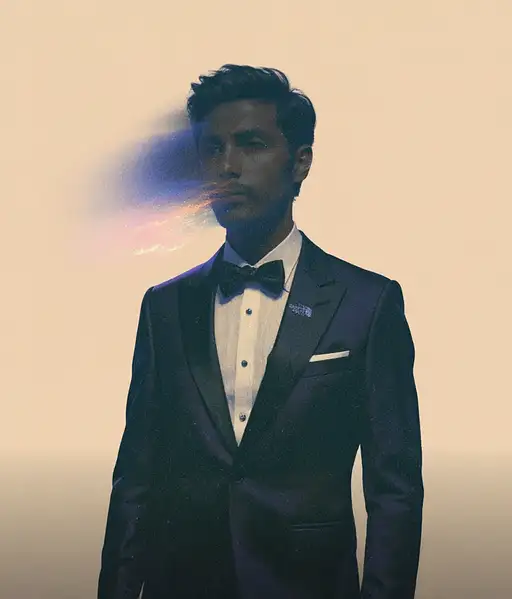
2 months ago
A surreal, low-angle portrait of a man dressed in an eveningwear elegant black dress, standing against a soft, light-colored background (beige or pale pastel). The camera looks up at them from below, creating a dramatic and imposing perspective. The figure is mostly in shadow — their face obscured by darkness and motion blur, as if dissolving into light. Soft, glowing highlights catch on the edges of their outfit, with hints of deep purples or gold reflections. The background remains smooth and minimal, enhancing the sense of isolation and mystery. Stylised, dreamy, and ethereal — a fusion of fashion photography, vaporwave tones, and surreal light effects.
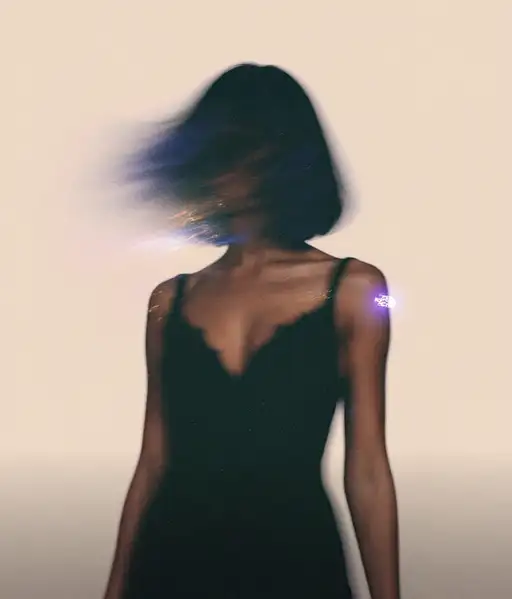
2 months ago
A surreal, low-angle portrait of a woman dressed in an eveningwear elegant black dress, standing against a soft, light-colored background (beige or pale pastel). The camera looks up at them from below, creating a dramatic and imposing perspective. The figure is mostly in shadow — their face obscured by darkness and motion blur, as if dissolving into light. Soft, glowing highlights catch on the edges of their outfit, with hints of deep purples or gold reflections. The background remains smooth and minimal, enhancing the sense of isolation and mystery. Stylised, dreamy, and ethereal — a fusion of fashion photography, vaporwave tones, and surreal light effects.
